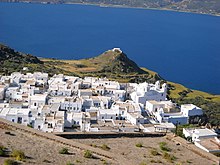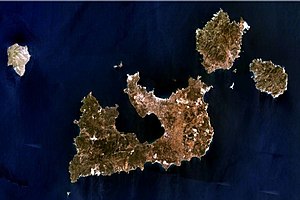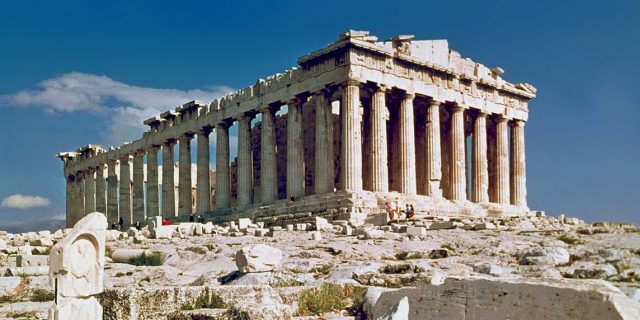Μήλος
( Milos )Milos or Melos (; Modern Greek: Μήλος, romanized: Mílos, IPA: [ˈmilos]; Ancient Greek: Μῆλος, romanized: Mêlos) is a volcanic Greek island in the Aegean Sea, just north of the Sea of Crete. Milos is the southwestern-most island in the Cyclades group.
The Venus de Milo (now in the Louvre), the Poseidon of Melos (now in the NAMA) and the Asclepius of Milos (now in the British Museum) were all found on the island, as was an archaic Apollo now in Athens. Milos is a popular tourist destination during the summer. The municipality of Milos also includes the uninhabited offshore isla...Read more
Milos or Melos (; Modern Greek: Μήλος, romanized: Mílos, IPA: [ˈmilos]; Ancient Greek: Μῆλος, romanized: Mêlos) is a volcanic Greek island in the Aegean Sea, just north of the Sea of Crete. Milos is the southwestern-most island in the Cyclades group.
The Venus de Milo (now in the Louvre), the Poseidon of Melos (now in the NAMA) and the Asclepius of Milos (now in the British Museum) were all found on the island, as was an archaic Apollo now in Athens. Milos is a popular tourist destination during the summer. The municipality of Milos also includes the uninhabited offshore islands of Antimilos and Akradies. The combined land area is 160.147 square kilometres (61.833 sq mi) and at the 2021 census the population was 5,193 inhabitants.
 The Lady of Phylakopi (14th-century BC) in the Archaeological Museum of Milos
The Lady of Phylakopi (14th-century BC) in the Archaeological Museum of MilosObsidian (a glass-like volcanic rock) from Milos was a commodity as early as 15,000 years ago.[1] Natural glass from Milos was transported over long distances and used for razor-sharp "stone tools" well before farming began and later: "There is no early farming village in the Near East that doesn't get obsidian".[2] The mining of obsidian did not lead to the development of permanent habitation or manufacturing on the island. Instead, those in search of obsidian arrived by boat, beaching it in a suitable cove and cutting pieces of the volcanic glass from the quarries.[3]
The position of Milos, between mainland Greece and Crete, and its possession of obsidian, made it an important centre of early Aegean civilisation. Milos lost its arms-making importance when bronze became the preferred material for the manufacture of weapons.[4]
The Bronze AgeThe first settlement at Phylakopi (Greek Φυλακωπή) arose in the Bronze Age, flourishing as the extraction of obsidian was in the decline. The first settlers were tuna fishermen.[3] Lying on the north-east coast, 1896 excavations by the British School at Athens and later in 1973 by the Brirish archaeologist Colin Renfrew,[5][6] revealed a town wall and a Minoan-inspired structure, dubbed the Pillar room, which contained fragments of vivid wall paintings. The famous fresco of the flying fish[7] was found in the ruins of the Pillar room and was executed with delicate colouring and graphic observation of nature in the graceful movement of a fish. Stylistic similarities to Minoan frescoes are suggested, and it could perhaps have been the work of a Cretan artist.[8] Part of the site has been washed away by the sea.
The antiquities found at the site covered three major periods, from the Early Cycladic period to the Mycenaean period. At the site much pottery was excavated, with several changing styles and influences over the site's long occupation. In the early occupation of the site, there are many similarities and imports from other Cycladic islands and the settlement was very small. During the Middle Bronze Age however, the site expanded significantly and the expansion of Minoan Crete saw an influx of Minoan pottery into the Cyclades, particularly at Akrotiri on Thera, though much found its way to Phylakopi. The quantities found at the Cycladic sites have been taken to suggest a Minoan control over the region, though it could also be the consumptive nature of the islanders adopting Cretan fashions. There is more than just pottery at Phylakopi however, the eruption of the Thera volcano saw a reduction in Minoan presence in the Cyclades and it is at this time that Mycenaean involvement on the islands increases. At Phylakopi (and unknown in the rest of the Cyclades) a megaron structure, which is typically associated with the Mycenaean palaces, such as those at Tiryns, Pylos and Mycenae has been discovered. This has been taken to suggest that the Mycenaeans conquered the settlement and installed a seat of power for a governor. The evidence is not clear, though again it could be a legacy of the islanders adopting foreign elements into their culture. Particularly unexpected was the discovery in the 1970s of a shrine at the site, which contained many examples of Aegean figurines, including the famous "Lady of Phylakopi". The shrine is unprecedented in the Bronze Age Cyclades and has provided a valuable insight into the beliefs and rituals of the inhabitants of Phylakopi. The site was eventually abandoned and was never reoccupied.
Dorian settlementThe first Dorian settlement on Melos was established no earlier than the 1st millennium BC. Dorians are the ethnic group to which the Spartans belonged, but the Dorian settlers of Melos made themselves independent. They eventually established a city whose site lies on the eastern shore of the bay, just south-west of the present-day community of Trypiti.
From the 6th century BC up to the siege of 416 BC, Melos issued its own coinage, struck according to the Milesian weight standard: the base coin was the stater which weighed just over 14 grams.[10][11][12] Melos was the only island in the Aegean Sea to use this standard.[13] Most coins bore the image of an apple, which is a pun because the ancient Greek word for "apple" (mêlon) sounded similar to the name of the island.[14] The coins also often bore the name of its people: ΜΑΛΙΟΝ (Malion) or some abbreviation thereof.[15]
By the 6th century BC, the Melians had also learned to write, and they used an archaic variant of the ancient Greek script that exhibited Cretan and Theraic influences. It was discarded after the siege of 416 BC.[16]
Α Β Γ Δ Ε Ϝ Ζ Η Η Θ Ι Κ Λ Μ Ν Ξ Ο Π Ϻ Ϙ Ρ Σ Τ Υ Φ Χ Ψ Ω Laconia(Sparta)
(Athens)
 A Melian stater from the 5th century.
A Melian stater from the 5th century. Melian terracotta relief depicting Triton and Theseus.
Melian terracotta relief depicting Triton and Theseus.From at least as early as 470 BC and ending with the siege of 416 BC, the Melians exported terracotta reliefs, which were typically use as door or chest ornaments and depicted scenes from mythology.
During the second Persian invasion of Greece in 480 BC, the Melians refused to submit to Persia and contributed two warships to the Greek war effort, which were used at the Battle of Salamis.[17] After the battle, the Melians returned to their traditional isolationism.[18]
Siege of 416 BCDuring the Peloponnesian War (431-404 BC) between Athens and Sparta, the Melians made some small donations to the Spartan war effort,[19][20] but remained largely neutral despite sharing the Spartans' Dorian ethnicity. In 426 BC, the Athenians raided the Melian countryside, and the following year demanded tribute,[21] but Melos refused. In the summer of 416 BC, Athens invaded again with 3,400 men, and demanded that Melos ally with them against Sparta, or be destroyed. The Melians rejected this, so the Athenian army laid siege to the city and eventually captured it in the winter. After the city's fall, the Athenians executed all the adult men,[22] and sold the women and children into slavery. They then settled 500 of their own colonists on the island.[23] In 405 BC, with Athens losing the war, the Spartan general Lysander expelled the Athenian settlers from Melos and repatriated the survivors of the siege.[24][25] Sparta annexed Melos, which would mean that like other liberated islands, it received a military governor (a harmost).[26]
The tribulations of its population and the loss of its independence meant that the cultural distinctiveness of Melos faded away as it was absorbed into mainstream Greek culture.[27] Their coinage switched to the Rhodian standard[28] (tetradrachms weighing 15.3 g[29]) and ceased bearing the word ΜΑΛΙΟΝ. The production of its terracotta reliefs also ceased.
The Hellenistic periodIn 338 BC, Philip II of Macedon defeated the Greeks at the Battle of Chaeroneia and became the overlord of Greece and the Cyclades. During this time, Melos and the nearby island Kimolos disputed each other over the ownership of the islands of Polyaigos, Heterea, and Libea (the last two are probably today's uninhabited islands of Agios Efstathios and Agios Georgios). In the past, this dispute would have been settled by war, but the two communities took their dispute to Argos on the Greek mainland. The Argives decided the islands belonged to Kimolos.[30]
The Roman and Byzantine periodIn 197 BC, the Romans forced Philip V to withdraw from Greece, and Melos subsequently came under Roman influence.
During the early 9th century CE the Cyclades were harassed by Arab raiders, though how Milos fared at this time is unclear. Milos was mentioned in a Byzantine chrysobull of 1198, which shows it was still important to the Byzantines.[31]
Medieval period Fifteenth century map by Cristoforo Buondelmonti.
Fifteenth century map by Cristoforo Buondelmonti.In the aftermath of the Fourth Crusade (1204), the Venetian Marco Sanudo seized control of Milos and a number of other islands in the Cyclades. Sanudo declared himself the Duke of Naxos, after the island where he established his capital. Sanudo did not make his duchy a vassal of Venice, but instead declared loyalty to the Latin Emperor.[32] Sanudo's dynasty lasted nine generations, then was succeeded by the Crispos. Both families were Catholic. The majority of the population was (and still is) Greek Orthodox.
Up to this point, the population of Melos was overwhelmingly Greek Orthodox Christian, just like the rest of the archipelago. When the Venetians conquered the archipelago, they brought Catholicism with them. The first Catholic bishop of Milos was appointed in 1253.[33]
Ottoman periodIn 1566 the Venetians handed over the Duchy of Naxos to the Ottoman Empire, and its last Catholic duke fled to Venice. The Ottoman sultan Selim II appointed a Portuguese Jew named Joseph Nasi as its duke. Upon Nasi's death in 1579, the Ottomans formally annexed the territory.[34]
 Women's dress in the early 18th century.
Women's dress in the early 18th century.In the early 18th century, the population surpassed 6,000[35] and was almost entirely Greek and Christian. It was ruled by Turkish judge or kadi, and a Turkish governor or voivode. The voivode was responsible for collecting taxes and enforcing the decisions of the kadi. The day-to-day affairs of the island were managed by three elected magistrates (epitropi), although any of their decisions could be appealed to the kadi. The island had two bishops: one Greek Orthodox and one Latin Catholic. The Greek bishop was wealthier than his Latin counterpart, as he had a larger revenue base. Although the islanders enjoyed a great degree of autonomy, they chafed under the heavy taxation of their Ottoman overlords.[36][37]
In 1771 the island was occupied by the Russian Empire for three years, then retaken by the Ottomans.
In the late 18th century, the population declined considerably for uncertain reasons.[38] By 1798, it had fallen below 500 people.[39] Visitors reported that up to two thirds of the buildings had fallen into ruin. It began growing again in the early 19th century, reaching 5,000 people by 1821.[40] Reliable figures are hard to find as the Ottoman Empire never performed a census before 1881.
Modern period The port of Adamas.
The port of Adamas. Chora (Plaka) of Milos
Chora (Plaka) of MilosMilos was one of the first islands to join the Greek War of Independence of 1821. The first naval battle of the war took place off the coast of Milos on 11 April 1821.[41] Milos became a refuge for refugees from numerous islands, particularly Crete. The port town of Adamantas was founded by Cretan refugees from the Cretan Revolt in 1841.[42][43]
When Theodore Bent toured the island in December 1883, note-taking for his guide to the Cyclades, he found that “There is a lack of energy nowadays in Melos, for Syra monopolises all the trade that once came here, and the Cretan exiles refuse to cultivate as they ought the fertile centre of the island, for they are only awaiting a favourable turn in events to return to their own island…”[44]
During the 19th century, Milos was a major rendezvous point for American and British ships fighting Muslim pirates in the Mediterranean.[citation needed]
In February 1943, 14 male civilians were executed for collecting material owned by the German occupation forces that was washed up after the sinking of a cargo ship by Allied aircraft.[citation needed]
The population peaked in 1928 at 6,562 people.[45] In 2011 it was 4,977.
The key word in the account by Thucydides is hebôntas (ἡβῶντας), which generally describes people who have passed puberty and in this context refers to the men as Thucydides described a different fate for the women and children. Some translators such as Rex Warner translated this as "men of military age". Another possible translation is "men in their prime". Thucydides made no specific mention of what happened to the elderly males. ^ Thucydides. History of the Peloponnesian War, 5.84-116 ^ Xenophon. Hellenica, 2.2.9: "Meantime Lysander, upon reaching Aegina, restored the state to the Aeginetans, gathering together as many of them as he could, and he did the same thing for the Melians also and for all the others who had been deprived of their native states." ^ Plutarch. Life of Lysander, 14.3: "But there were other measures of Lysander upon which all the Greeks looked with pleasure, when, for instance, the Aeginetans, after a long time, received back their own city, and when the Melians and Scionaeans were restored to their homes by him, after the Athenians had been driven out and had delivered back the cities." ^ Brian Sparkes, in Renfrew & Wagstaff (1982), p. 49-50: "Melos thus passed from Athenian to Spartan control, and the Melians who returned found a government of ten established, made effective by the presence of a Spartan garrison and of a harmost or military commander." ^ Brian Sparkes, in Renfrew & Wagstaff (1982) ^ Brian Sparkes, in Renfrew & Wagstaff (1982), p 231 ^ O'Hara, Robert James (1959-). "History, Metals, and Weight Standards (Ancient Coins of Miletos)". rjohara.net. Retrieved 25 March 2019.{{cite web}}: CS1 maint: numeric names: authors list (link) ^ Brain Sparkes, in Renfrew & Wagstaff (1982), p 50 ^ Renfrew & Wagstaff (1982), p. 58 ^ Renfrew & Wagstaff (1982), p. 58-69 ^ "Diocese of Milos, Greece". GCatholic. Retrieved 25 March 2019. ^ "History of Milos island - Greeka.com". Greeka. Retrieved 25 March 2019. ^ Cite error: The named reference RenfrewWagstaff1982 was invoked but never defined (see the help page). ^ Tournefort (1717), p. 180-181 ^ Thompson (1752), vol 1, p. 291-300 ^ Renfrew & Wagstaff (1982), p. 69 ^ Cite error: The named reference Olivier1801p156 was invoked but never defined (see the help page). ^ Cite error: The named reference RenfrewWagstaff1982p148 was invoked but never defined (see the help page). ^ "History of Milos island | Greeka". Greekacom. Retrieved 2022-06-24. ^ "Milos". www.greece.org. Retrieved 2022-06-24. ^ Heikell, Rod (2020-01-01). West Aegean. Imray, Laurie, Norie and Wilson Ltd. p. 212. ISBN 978-1-78679-089-7. ^ Theodore Bent, The Cyclades, or Life Among the Insular Greeks (London, 1885, pp. 57ff.). ^ Renfrew & Wagstaff (1982), p. 70





























Add new comment